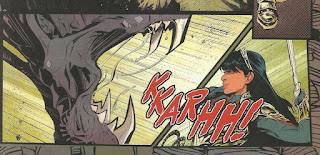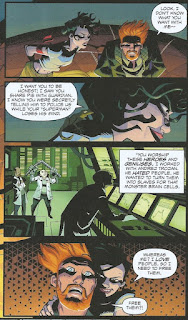Wednesday, January 20, 2021
POBB January 19, 2021
Wednesday, January 13, 2021
POBB January 12, 2021
Pick of The Brown Bag
January 12, 2021
by
Ray Tate
The Pick of the Brown Bag returns with a look at Generations, Superman in Metropolis and Wonder Woman. The latter two being not quite the Superman or Wonder Woman you know, thanks to Death Metal apparently. Another maxi-series I ignored.
I'm reviewing only three books this week, but you're busy people. You have schedules to keep. So, if you still don't have time for these paltry three check out the teensy reviews on Twitter: #PickoftheBrownBag
Dan Jurgens intrigued me with his short story in Detective Comics 1027.
Batman contemporary morphs into Batman original.
SPOILER ENDS
This story proved to be a soupçon for a promised mini-series. So, I bought the first issue as soon as it hit the stands.
Sucker.
Turns out to be just another rotten Crisis on Infinite Earths knock-off.
Damn it.
See. Time-morphing heroes? That’s interesting. That’s original. That’s not what you get. Instead, Old Eyepatch Booster Gold saves Kamandi from Crisis Erasure Waves.
Booster’s wounded and passes transmogrified A.I. Skeets to Kamandi. That’s why the Last Boy on Earth is wearing a glam glove.
By the way if these names throw you, maybe this book is too entrenched in DC Continuity, and it’s not for you. Here’s the run down though.
Jack Kirby created Kamandi, The Last Boy on Earth soon after seeing the original Planet of the Apes circa late sixties. Dan Jurgens originated Booster Gold soon after Crisis as a cynical counterpoint to Superman. That young Booster Gold shows up in Generations as well.
I never liked Booster Gold until the New 52 rebooted him as a credible hero. Later, Jimmy Palmiotti and Justin Gray, in All-Star Western, turned him into an effective time traveler. Before all that Booster Gold only worked for me as part of a double-act with the Blue Beetle, in the comedy era of the Justice League.
Despite my overall roughly twenty plus year disdain for Booster Gold, he was about a million times better than another Jurgens creation, also appearing in Generations.
Waverider. This low-rent Silver Surfer’s greatest contribution to the DC Universe is lending his name to The Legends of Tomorrow's time-ship.
So, yeah. Generations is another Crisis on Infinite Earths with Kamandi acting as the Monitor. He gathers the heroes he needs or can to stop the Erasure Waves. These figures include: Sinestro as a Green Lantern, Starfire just when she joins the Teen Titans, Steel quickly after Superman's death, the pre-Crisis Superboy, New 52 heroic Dr. Light, and time-morphed Batman, good explanation not given.
Okay...That makes no sense at all. You're erasing things left and right. You're erasing the entire Legion of Super-Heroes. So, why time-morph Batman? If you've got all this power, why not just kill him? In fact that should be first on the to-do list for all wannabe dictators. Number one, kill Batman. If you can't check that off, I suggest you forget about the whole scheme. Any Batman from any period is a massive spanner waiting to wreck the works.
That’s a Superman villain in the shadows, by the by. No. No. I’ve given nothing away. This fellow is so obscure that I barely remember him.
The Big Stupid Event for DC Comics this week is Future State. I suppose you could describe this thing as what if scenarios—Elseworlds in DC tongue—that are set in the future.
The only one that stands out so far is Joelle Jones’ Wonder Woman, and that’s because this doesn’t read like a future Wonder Woman.
Jones doesn’t try very hard to set the story in the future. In fact she doesn’t date it at all. Future State Wonder Woman reads like Lucy Lawless portraying a young Wonder Woman that happens to be a South American named Yara Flor.
I know that Lucy Lawless is a Kiwi, but the attitude and bone structure matches. See if you don’t agree.
Part One of the setting is the Amazonian Jungle, but it’s not from around here. Monsters from Greek mythology rumble about.
Wonder Woman is the ideal slayer. The creative team ideal for Wonder Woman. Jones’ artwork energetic and Jordie Bellaire’s colors eye-catching.
As Wonder Woman ends Greek menaces, Jones, in the smooth narration, provides a digestible introduction for the new hero. Meanwhile, Yara’s dialogue contributes humor to the tale.
Who is Jerry? I’ll not be telling. It’s a fun little surprise and running gag.
In the second part of the book, a South American fairy accompanies Wonder Woman to the Underworld. After Yara introduces Caipora to her magic bolos.
Jones’ version of the legendary realm is much more comedic and completes the worth of the book.
You’ve got beautiful artwork, a slam-bang action hero, myths and monsters, a literate origin, an Easter Egg and some laughs. What more can a reader want? If you can only buy one of the Future State titles, make it Wonder Woman.
Superman of Metropolis on the other hand is simply dull. I bought the book for Supergirl's appearance, but she’s boring as well, and I can’t understand why. Artist John Timms helped make Harley Quinn fun, but his Supergirl underwhelms. Even when beating up Jonathan Kent.
I should really be into this. I never liked Jonathan Kent, but the battle just left me feeling tired. I don’t mean exhausted and exhilarated as if I had just watched Godzilla.
I mean like maybe I’ve been reading comic books for too long kind of tired. I perused Superman in Metropolis twice. So, it’s not like I was just actually fatigued. I gave it every opportunity to amuse me. It failed. Doubling down the ennui.
Maybe it’s because Supergirl and Super Boy-Man don’t smile, don’t seem happy and don’t seem like themselves. Yeah, some freaky pair of Nano-Lips is controlling Supergirl, but she doesn't smile even when free.
I just would like some joy. Humanity suffered through the worst year, and you lot can’t give me a smiling Supergirl. Marc Andreyko and Kevin Maguire did actually in 2020.
That was when Supergirl sought out vengeance among the stars. She still took time to be happy. I really don’t need to read about a sourpuss Kara. Is nobody but Yara cheerful in DC’s Future State? I wouldn’t be either. It looks like a terrible place.
Incidentally, Jonathan Kent is Superman’s and Lois Lane’s son, named after Pa Kent. Now, bear with me. Jonathan Kent used to be the little kid, hanging out with Damien Wayne, the sixth Robin. Batman’s and Talia’s son.
Little Jonathan grew up real fast while in space, but nobody on earth aged a whit, including Robin. It’s kind of the reversal of the Twin Paradox and doesn’t make sense. What it boils down to is the Powers That Be at DC needed a Superboy for the newly revamped Legion of Super-Heroes. So, Little Jonathan had to become Bigger John post haste.
Johnathan becomes Superman in Future State and the protector of Metropolis while his Dad’s saving other planets or something. That’s so traditional I can almost hear the chestnuts roasting on an open fire.
Metropolis originally was just a normal city. Over the years it became…a normal city. For a few blips, a writer or artist made it a sort of art deco concept car, only a city, but for the lion’s share of its existence Metropolis was/is just a normal city. In Superman in Metropolis, the city becomes more like something from Judge Dredd. That doesn’t work for me, and there’s not enough explanation regarding the descent.
In the second story Shilo Norman becomes a citizen of Metropolis to put him in the right place at the right time to fight robots from who knows where.
I just get the impression that Brandon Easton wanted to write a Mister Miracle story and he saw an opportunity when Superman in Metropolis needed more pages to fill.
“Wait a minute! Shilo Norman has a tenuous connection to Metropolis!”
The story’s not bad, but it’s not Mister Miracle. Jack Kirby created the original Mister Miracle Thaddeus Brown, the second Mister Miracle Scott Free and the third Mister Miracle Shilo Norman. In all issues of Mister Miracle, Kirby endorsed an escapology theme. In Easton’s story, not so much.
The third tale is the most Judge Dredd of them all. Actual Metropolis hero the Guardian teams up with an older hirsute Jimmy Olsen.
They aim to expose Honest Mary, who’s a lot like Dredd’s Mamma. Although, she’s not a drug dealer. Cause it’s a Superman comic book. Sort of.
The story’s…okay, I suppose. There’s a bit of amusement in the Guardian partnering with Jimmy Olsen. In Supergirl, Jimmy Olsen assumes the guise of the Guardian. I miss Supergirl.
The entirety of the book just doesn't gel for me. All of this futureshock doesn't suit Superman. Superman is all about optimism and making the world a better place, little by little, one super feat at a time.





























































